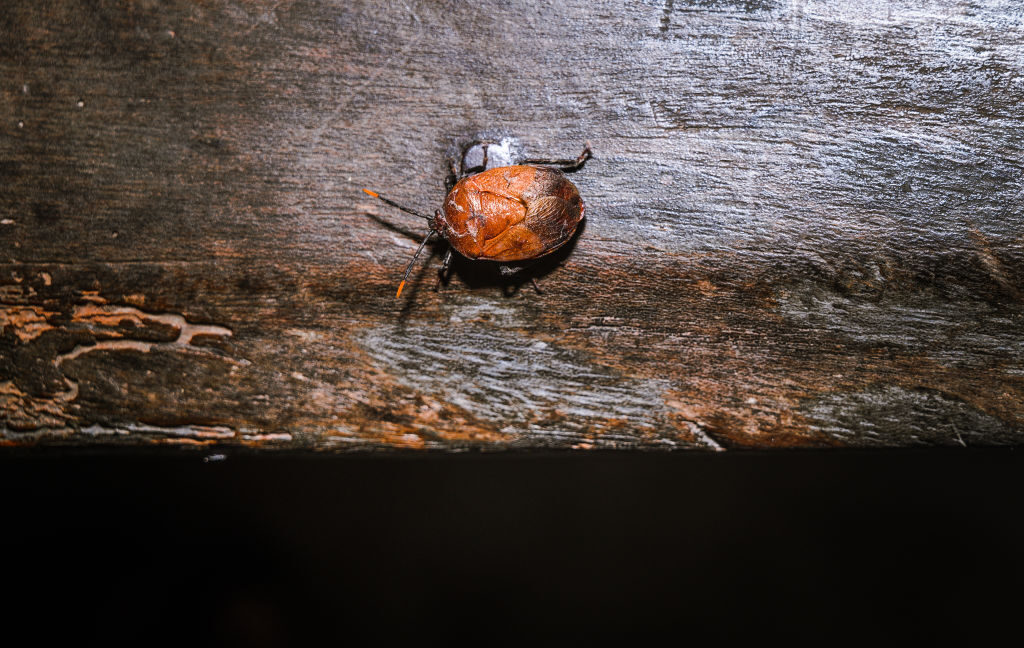Copyright Ars Technica

Many insect species hear using tympanal organs, membranes roughly resembling our eardrums but located on their legs. Grasshoppers, mantises, and moths all have them, and for decades, we thought that female stinkbugs of the Dinidoridae family have them, too, although located a bit unusually on their hind rather than front legs. Suspecting that they use their hind leg tympanal organs to listen to male courtship songs, a team of Japanese researchers took a closer look at the organs in Megymenum gracilicorne, a Dinidoridae stinkbug species native to Japan. They discovered that these “tympanal organs” were not what they seemed. They’re actually mobile fungal nurseries of a kind we’ve never seen before. Portable gardens Dinidoridae is a small stinkbug family that lives exclusively in Asia. The bug did attract some scientific attention, but not nearly as much as its larger relatives like Pentatomidae. Prior work looking specifically into organs growing on the hind legs of Dinidoridae females was thus somewhat limited. “Most research relied on taxonomic and morphological approaches. Some taxonomists did describe that female Dinidoridae stinkbugs have an enlarged part on the hind legs that looks like the tympanal organ you can find, for example, in crickets,” said Takema Fukatsu, an evolutionary biologist at the National Institute of Advanced Industrial Science and Technology in Tokyo. Based on that appearance, these parts were classified as tympanal organs—the case was closed, and it stayed closed until Fukatsu’s team started examining them more closely. Most insects have tympanal organs on their front legs, not hind legs, or on abdominal segments. The initial goal of Fukatsu’s study was to figure out what impact this unusual position has on Dinidoridae females’ ability to hear sounds. Early on in the study, it turned out that whatever Dinidoridae females have on their hind legs, they are not tympanal organs. “We found no tympanal membrane and no sensory neurons, so the enlarged parts on the hind legs had nothing to do with hearing,” Fukatsu explained. Instead, the organ had thousands of small pores filled with benign filamentous fungi. The pores were connected to secretory cells that released substances that Fukatsu’s team hypothesized were nutrients enabling the fungi to grow. What Fukatsu discovered was a mobile, self-sustaining fungal garden. “In adult female, this organ was covered with white fungal hyphae,” Fukatsu said. So far, a functionally similar feature has been found in insects like Ambrosia Beetles, which have pocket-like organs used to transport and release fungal spores into holes bored in wood. This way, the beetles create fungal gardens that their larvae and adults can feed on. But in Dinidoridae, the purpose of mobile fungal nurseries is entirely different. The stinkbugs use the fungi to cover their eggs with fungal blankets. Keeping wasps at bay To find out how Megymenum gracilicorne females use their fungal nurseries, Fukatsu and his colleagues observed the bugs in both the lab and in the wild. “They lay eggs in a row and they smear the fungal spores on each egg,” Fukatsu explained. During oviposition, the females scratched their fungal nurseries with a claw on the other leg and then rubbed the eggs. Within three days, the eggs were almost entirely covered with a roughly two-millimeter-thick layer of fungi. The purpose of these fungal blankets was to protect the eggs from parasitic wasps. “When the eggs were covered, the wasps could not approach them—pierce through them to lay their own eggs in the Dinidoridae stinkbug eggs,” Fukatsu said. The team performed a series of experiments that involved releasing the wasps in a container with stinkbug eggs fully covered with fungi and eggs where the fungal blanket was artificially scraped off. It turned out that the blankets significantly reduced the wasp parasitism. The wasps managed to parasitize 62 percent of the fungi-free eggs. In eggs covered with the fungal blankets, this rate was down to 10 percent. Surprisingly, the fungi did not infect the wasps or cause them any harm; the blankets worked more like a physical barrier than a chemical deterrent. “Even when we kept the wasps in Petri dishes full of spores for a full day, they were very happy—they never died,” Fukatsu explains. This finding led the team to question how Dinidoridae females picked a fungus with these properties. “In young females, the hind leg organs are sterile, so they collect the fungi upon reaching maturity,” Fukatsu said. “But there are so many different fungi and microbes out there and we still don’t know for sure how they pick the right ones.” And that was just the first item on the list of things we still don’t know. Picky collectors The question about the way Dnidoridae stinkbug females pick the right fungi became even more mysterious when the team realized the fungal species in the nursery organs differed from individual to individual. “So chance must play a part in choosing which fungi to collect. Still, the fungi we found in the organs belonged to two or three very specific benign groups,” Fukatsu said. What we do know for now is that the fungi were not pathogenic to the insects, the eggs, or the wasps. We also don’t know the nature of the nutrients secreted by the cells at the bottom of the pores in the organs, which the team thinks can play a crucial part in making sure they are populated by the right fungi. The nutrients might be tuned to sustain only the right species of fungi, but it remains an open question. Arguably the largest mystery is how these fungal nurseries evolved. So far, Fukatsu’s team found them in just a few stinkbug species of the Dinidoridae family living in Japan and Taiwan, which makes them rather unique. “We would like to do a developmental study to see what gene transmission leads to this female-specific organs, and we’re already compiling a huge list of genes that are upregulated in these organs,” Fukatsu said. The team is doing an early screen, knocking down specific candidate genes in stinkbug females to see how this affects their phenotype. “This way we hope to identify the genes involved in formation of these fungal nurseries,” Fukatsu said. Science, 2025. DOI: 10.1126/science.adp6699



